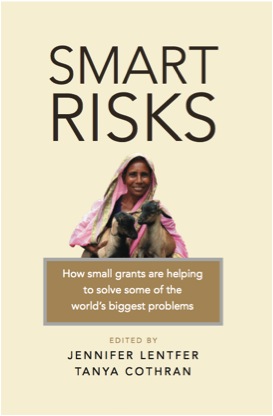This is how it began…
From: JENNIFER LENTFER
Date: Wed, Oct 5, 2011 at 5:29 PM
Subject: invitation to join “Small is Big” Writing Collaborative<
To: Tanya Cothran
Dear Tanya,
As people making small grants internationally, you are part of a growing number of people that specialize in offering direct funding to local initiatives and community leaders.
You have vital expertise to share with the aid and philanthropic sectors as many are wondering what more can be done to enable grassroots movements to emerge and gain strength.
Therefore I am inviting you to share your experience via the “Small is Big” Writing Collaborative, which aims to gather varied grantmakers’ approaches and experiences as a collective source of knowledge to share widely via an online or printed publication. In the collaborative, you and/or your staff will be engaged in a reflective learning process with my support and that of participants from other organizations…
***
And five years, 22 contributors (and many other supporters and friends along the way), here is where we ended up…
Coming April 2017
from Practical Action Publishing!
In a rapidly changing world and after decades of failed international aid, it’s high time to build the dialogue about how international actors can build their own skills and institutional processes to accompany and support community-level leadership and systems, rather than overpower or co-opt them.
Luckily there is a growing number of small NGOs and foundations that specialize in offering direct, responsive funding to grassroots leaders and small, often “informal” initiatives, groups, and movements. And over twenty of them have come together to write this book!
Compared to the old-school, donor-controlled, large-scale, project-based international aid funding, the authors use the concept of “smart risks” to build upon existing human and social capital to unleash people power and social innovation. International grassroots grantmakers are adept at keeping their minds (and perhaps more importantly their hearts) open to the possibility of results when the common good is tapped in unimagined and unanticipated ways.
Expertise about how best to supporting ground-up organizations and movements is too often missing from the discussions of “what works” in our field. Authors offer viable and practical alternatives to traditional modalities of giving. As international grassroots grant makers, they create broad guidelines, focus areas, and selection criteria to respond to what local stakeholders view as important – which often takes the form of long-term general operating support.
From individuals with small contributions to make, to large philanthropists and heads of international organizations with portfolios of millions to spend, readers will be asking:
- What are the best kinds of funding mechanisms that will increase grassroots organizations’ responsiveness and resourcefulness, rather than distract them from their purpose, and most importantly, their constituencies?
- What are the minimum structures and financial controls necessary to get more people a seat at the decision-making table about how resources are allocated? In other words, how do we continually question the sources of power in our day-to-day work?
- In all of the seemingly mundane acts of planning, coordinating and monitoring projects, how do we acknowledge the deep and profound difference between service delivery and social change?
- What’s needed to incentivize the “risk-taking” needed on the part of donors of all sorts to get more money to the ground, quicker than ever before?
People in poor countries or communities who want to make change should no longer tolerate an charity-modeled system that makes them struggle and wait endlessly for funding to trickle down to them, marred by burdensome requirements and restrictions from donors. Pushing the sector forward needs smart risk-taking, and the authors’ experience is an untapped resource for the international aid and philanthropic sectors as a whole.
Smart Risks contributors came together because they each have a professional – and perhaps more importantly a personal – resolve to build solidarity with people not as passive recipients of aid, but as whole people and active leaders of their own lives. We know that radical shifts in thinking, attitude, and practice are required and we hope that this book can contribute to shifting the power and charting new paths ahead!
***
Related Posts
Does aid need a 12-step program?
“Create” nothing, a new social good mantra
Getting money to the ground, directly
A new kind of donor: 4 things they do differently
Actually, it was my capacity that needed to be built
White supremacy, black liberation, and global development: The conversations we’re not having
Briefcase NGOs: How widespread is this, really?
Time to Listen? Time to address our organizational barriers
Subjective, squishy, touchy, feely, and fundamental: Partnership matters


Congratulations, cannot wait to buy and read it.
Thank you Jennifer! It has been deeply rewarding to work on this project with you and all the amazing contributing authors!
You make me proud. Congratulations.
Pingback: Five years in the making... | Spirit in Action International
Congratulations! I will be reading Smart Risks soon.